

Arbroath Abbey. Arbroath Abbey, showing distinctive sandstone colouring.

Arbroath Abbey, in the Scottish town of Arbroath, was founded in 1178 by King William the Lion for a group of Tironensian Benedictine monks from Kelso Abbey. It was consecrated in 1197 with a dedication to the deceased Saint Thomas Becket, whom the king had met at the English court. It was William's only personal foundation — he was buried before the high altar of the church in 1214. History[edit] King William gave the Abbey independence from its mother church and endowed it generously, including income from 24 parishes, land in every royal burgh and more. Illustrated Guide to Places to Visit - Arbroath Abbey. Founded by William the Lion King William the Lion found out the hard way the power of prayer.
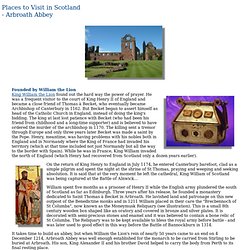
He was a frequent visitor to the court of King Henry II of England and became a close friend of Thomas à Becket, who eventually became Archbishop of Canterbury in 1162. But Becket began to assert himself as head of the Catholic Church in England, instead of doing the king's bidding. The king at last lost patience with Becket (who had been his friend from childhood and a long-time supporter) and is believed to have ordered the murder of the archbishop in 1170. Arbroath Abbey Feature Page on Undiscovered Scotland. Arbroath Abbey is located close to the centre of the town of Arbroath, which is itself on the coast 17 miles north east of Dundee.
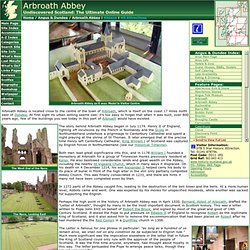
At first sight its urban setting seems odd: it's too easy to forget that when it was built, over 800 years ago, few of the buildings you see today in this part of Arbroath would have existed. The story behind Arbroath Abbey began in July 1174. Henry II of England, fighting off incursions by the French in Normandy and the Scots in Northumberland undertook a pilgrimage to Canterbury Cathedral and spent a night praying at the shrine of St Thomas. It later emerged that at the precise time Henry left Canterbury Cathedral, King William I of Scotland was captured by English forces in Northumberland (see our Historical Timeline). Both men read great significance into this, and in 1178 William I founded a monastery at Arbroath for a group of Tironesian monks previously resident at Kelso.
Perthshire, Angus & Dundee. Arbroath Abbey - Arbroath. "Explore the substantial ruins of a Tironensian monastery, founded by William the Lion in 1178, who is buried in Arbroath Abbey.

" Arbroath Abbey is famously associated with the Declaration of Arbroath of 1320, which asserted Scotland's independence from England. Parts of the abbey church and domestic buildings remain, notably the gatehouse range and the abbot's house. Visitors can enjoy the herb garden along the south wall of the abbey church. The visitor centre provides a walk through audio-visual with a sound loop system. There is also a staff operated platform to enable disabled access to the upper viewing area. ARBROATH ABBEY Property Detail. Getting there | Facilities & access | Opening arrangements & costs | Contact Getting there Region – Perthshire, Kinross and Angus Postcode: DD11 1EG Cycle RoutesSite on the National Cycle Network Public TransportRegular trains to Arbroath.
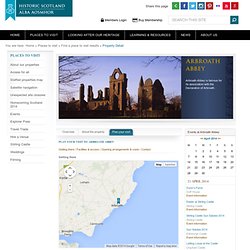
From Arbroath train station, walk 6 mins to Abroath Abbey. SatNav Historic Scotland Sites downloads Download our site locations to your satellite navigation system. Arbroath Abbey Property Detail. Historic Buildings. Foundation of the Abbey King William the Lion founded the Arbroath Abbey in 1178 in honour of the murdered St.

Thomas, Archbishop of Canterbury. Bellrock.org.uk : Arbroath : Abbey of Aberbrothock. The history of Arbroath (or, to give it its old name, Aberbrothock, meaning "at the mouth of the Brothock", the stream which runs through the town) begins with the building of its great Abbey.
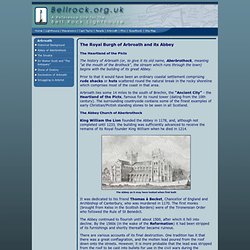
Prior to that it would have been an ordinary coastal settlement comprising rude shacks or huts scattered round the natural break in the rocky shoreline which comprises most of the coast in that area. Arbroath lies some 14 miles to the south of Brechin, the “Ancient City” - the Heartland of the Picts, famous for its round tower (dating from the 10th century). The surrounding countryside contains some of the finest examples of early Christian/Pictish standing stones to be seen in all Scotland. Angus Heritage - Arbroath Abbey. Declaration of Arbroath. The 'Tyninghame' copy of the Declaration from 1320 AD The Declaration of Arbroath is a declaration of Scottish independence, made in 1320.
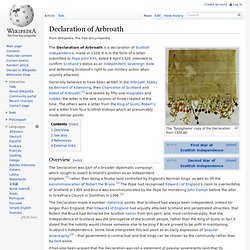
It is in the form of a letter submitted to Pope John XXII, dated 6 April 1320, intended to confirm Scotland's status as an independent, sovereign state and defending Scotland's right to use military action when unjustly attacked. Generally believed to have been written in the Arbroath Abbey by Bernard of Kilwinning, then Chancellor of Scotland and Abbot of Arbroath,[1] and sealed by fifty-one magnates and nobles, the letter is the sole survivor of three created at the time. The others were a letter from the King of Scots, Robert I, and a letter from four Scottish bishops which all presumably made similar points. Overview[edit] To this man, in as much as he saved our people, and for upholding our freedom, we are bound by right as much as by his merits, and choose to follow him in all that he does. See also[edit] References[edit] External links[edit] Declaration of Arbroath. Abbey of Arbroath. This monastery was founded on the east coast of Scotland (1178) by William the Lion, for Benedictines, and was colonized by monks from Kelso.

The foundation was in honour of St. Thomas of Canterbury, martyred eight years previously, with whom William had been on terms of personal friendship. At his death in 1214 William was buried in the eastern portion, then just finished, of the noble church, which was completed in 1233. It had a choir of three bays and a nave of nine, with side aisles, two transepts, a central and two western towers. Arbroath Abbey, Arbroath: Places to visit in Angus. Famous for its association with the Declaration of Arbroath Places to stay near here Introduction Arbroath Abbey is best known for the Declaration of Arbroath, arguably the most famous document in Scottish history.

When Robert Bruce defeated Edward II of England at Bannockburn in 1314, this did not end the Wars of Independence. Arbroath Abbey. BBC - The history of Arbroath Abbey. Red sandstone from the cliffs nearby was used to build Arbroath Abbey Arbroath Abbey was founded in 1178 by King William the Lion and dedicated to Thomas Becket. The abbey was established by Tironensian monks from Kelso Abbey who were invited by King William to establish a religious base in Arbroath. Site Record for Arbroath Abbey Aberbrothock AbbeyDetails Details. Arbroath Abbey. HERITAGE HIGHLIGHTS: The Declaration of Arbroath was written here - perhaps the most important document in Scottish history William the Lion, King of Scotland, was a close friend of Thomas Becket, Archbishop of Canterbury. When William decided to establish a Tironensian abbey at Arbroath in 1178, he dedicated the abbey to Becket. In so doing, he was thumbing his nose at Henry II of England, at whose instigation Becket was killed in 1170.
Arbroath Abbey. The document that we now call the Declaration of Arbroath is what makes this ruined abbey on Scotland’s east coast one of the most famous heritage sites in Britain. It was issued from here in 1320 and it was actually a letter written by a group of Scottish nobles to the Pope in Rome. Arbroath Abbey - Arbroath and St Vigeans, Tayside - Scottish Church Heritage Research. Scotland » Tayside » Arbroath and St Vigeans » Arbroath Abbey National Grid Reference (NGR): NO 64300 41330, map Address Abbey StreetArbroathAngusDD11 1JQScotland Introduction. Arbroath Abbey, Stirling Monks and Stonework Design. You are standing in the undercroft of the Abbot's house. It was attached to the abbey kitchens and the now demolished cloister. Later, the undercroft itself became a kitchen. From Tiron to Arbroath! The monks that lived and worked here were Tironensian, or grey monks. Photographs around Arbroath Abbey. Topofly: Arbroath Abbey and Tantallon Castle by Kite.
Two more successful kite aerial photography outings from last month. This first shot of Arbroath Abby presented an "interesting" challenge in urban KAP, with various trees, lamposts and buildings to avoid. I first approached this tall section of the abbey from straight on, thinking that the circular window would make a good central composition, but found this angle didn't work so well. This is a slightly more dynamic composition with the wall running into the corner. I like the long converging shadows on the bowling green - an effect which comes with the wide angle view available from low altitude. When it came to post-processing this image I was able to choose whether or not to crop out the horizon line which is just above the frame here. Looking at these two shots made me think about the difference which including the horizon makes - going from what feels like looking in upon something a little isolated and abstracted, to looking out upon a more familiar landscape view.
Stone’s destiny is Arbroath Abbey - Angus. Your Paintings - Historic Scotland, Arbroath Abbey. Arbroath - 'The Prospect of ye Abby of Aberbrothick' - John Slezer's Engravings of Scotland. Repeated fires and an attack from English forces were among the reasons why Arbroath Abbey wasn't really completed - or at least not for long.